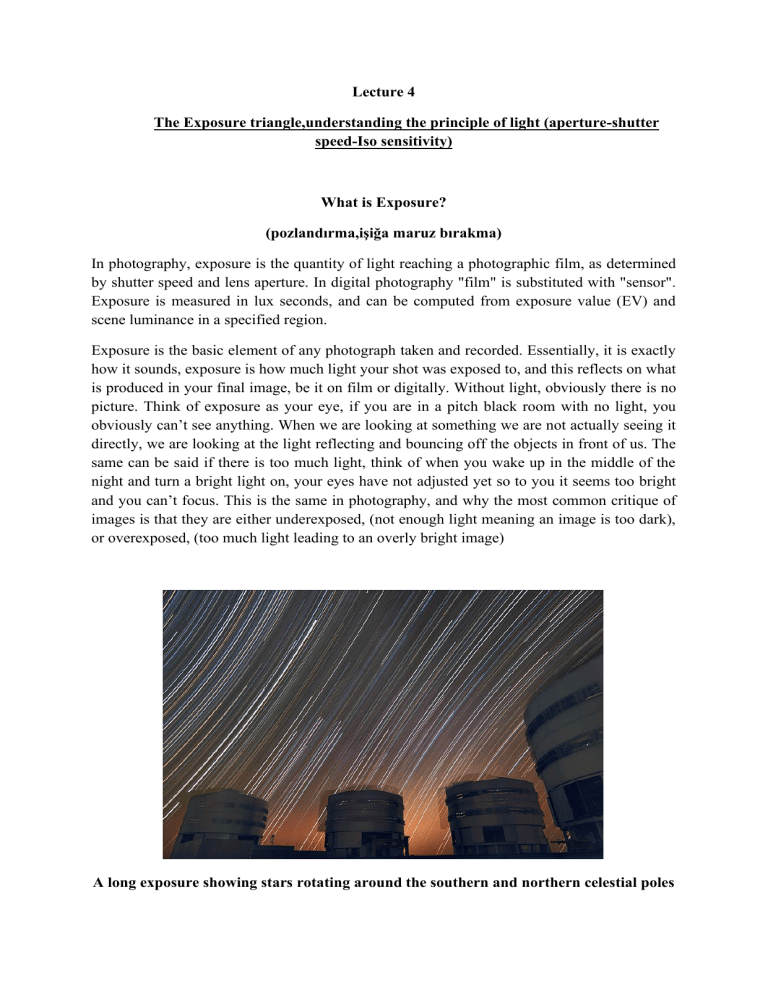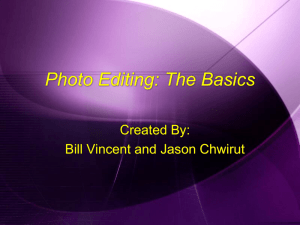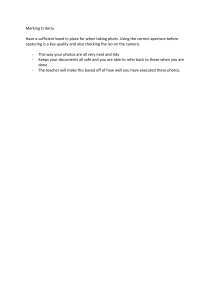
Lecture 4 The Exposure triangle,understanding the principle of light (aperture-shutter speed-Iso sensitivity) What is Exposure? (pozlandırma,işiğa maruz bırakma) In photography, exposure is the quantity of light reaching a photographic film, as determined by shutter speed and lens aperture. In digital photography "film" is substituted with "sensor". Exposure is measured in lux seconds, and can be computed from exposure value (EV) and scene luminance in a specified region. Exposure is the basic element of any photograph taken and recorded. Essentially, it is exactly how it sounds, exposure is how much light your shot was exposed to, and this reflects on what is produced in your final image, be it on film or digitally. Without light, obviously there is no picture. Think of exposure as your eye, if you are in a pitch black room with no light, you obviously can’t see anything. When we are looking at something we are not actually seeing it directly, we are looking at the light reflecting and bouncing off the objects in front of us. The same can be said if there is too much light, think of when you wake up in the middle of the night and turn a bright light on, your eyes have not adjusted yet so to you it seems too bright and you can’t focus. This is the same in photography, and why the most common critique of images is that they are either underexposed, (not enough light meaning an image is too dark), or overexposed, (too much light leading to an overly bright image) A long exposure showing stars rotating around the southern and northern celestial poles A photograph of the sea after sunset with an exposure time of 15 seconds. The swell from the waves appears as fog. Overexposure and underexposure A photograph may be described as overexposed when it has a loss of highlight detail, that is, when important bright parts of an image are "washed out" or effectively all white, known as "blown out highlights" or "clipped whites". A photograph may be described as underexposed when it has a loss of shadow detail, that is, when important dark areas are "muddy" or misty from black, known as "blocked up shadows" (or sometimes "crushed shadows," "crushed blacks," or "clipped blacks," especially in video). As the image to the right shows, these terms are technical ones rather than artistic judgments; an overexposed or underexposed image may be "correct", in that it provides the effect that the photographer intended. Intentionally overor under- exposing (relative to a standard or the camera's automatic exposure) is casually referred to as "shooting to the right" or "shooting to the left", respectively, as these shift the histogram of the image to the right or left. Example image exhibiting blown-out highlights. Top: original image, bottom: blown-out areas marked red Exposure compensation The purpose of an exposure meter is to guess the subject's mid-tone luminance and indicate the camera exposure settings required to record this as a mid-tone. In order to do this it has to make a number of assumptions which, under certain circumstances, will be wrong. If the exposure setting indicated by an exposure meter is taken as the "reference" exposure, the photographer may wish to deliberately overexpose or underexpose in order to compensate for known or anticipated metering inaccuracies. Cameras with any kind of internal exposure meter usually feature an exposure compensation setting which is intended to allow the photographer to simply offset the exposure level from the internal meter's estimate of appropriate exposure. Frequently calibrated in stops, also known as EV units, a "+1" exposure compensation setting indicates one stop more (twice as much) exposure and "–1" means one stop less (half as much) exposure. Snowy place without exposure compensation Same place with +1EV exposure compensation Understanding the Three Basic Elements of Photography (Aperture, Shutter, ISO) . Exposure is the making of an image on a digital sensor by using light. A photograph's exposure determines how light or dark an image will appear when it's been captured by your camera This is determined by three camera settings:(the "exposure triangle")Aperture, Shutter Speed and ISO. Changing any one of these will affect your exposure and one or both of the other two variables. Aperture (Diyafram-Açıklık) Aperture is the amount of light, which provides either shallow or large DOF (depth of field) controls the area over which light can enter your camera. Aperture is the setting which controls the size of the opening of light which comes through to the lens. Normally this is done by controlling the aperture blades which can be changed to allow the aperture to become smaller, in which less light is let through, or obviously larger where more light is allowed to pass through. Aperture is measured in f-stops, for example f/2.0, f/2.8. f/4.0 etc. The smaller the f-stop number, the larger the lens opening, and therefore the more light a lens can let in. This is why the sharper lenses with lower f-stops are normally more expensive than a similar lens which cannot match the same aperture, as the more expensive lenses can cope with low light situations better. For this reason, when someone is talking about the maximum aperture, this normally means the lowest f-stop available. The important thing to remember is that for every one stop the aperture is stepped down, the double the amount of light which will enter the sensor. The below picture shows the differing size of openings that an aperture will produce. This is of course provided you and the camera/lens follows the original aperture stops as shown below, as a lot of modern camera’s now have half stops, f/4.5, f/7.1 etc. for a more precise aperture. The aperture is also one of the most critical aspects of focusing. A large depth of field which is necessary when photographers want as much of the photograph in focus as possible, such as landscape photography, needs a minimum aperture as possible (high number). This allows objects in the foreground and background to be in focus. The opposite is obviously true of course, in that to achieve a shallow depth of field, where a particular point is in focus whereas the other parts of the image are blurred, a low f-stop should be used, (low number). This creates the beautiful bokeh we love, which adds dramatic effects to images where you want to highlight an object or subject, such as macro photography and portraiture shots. The bluebird was shot with a focal length of 270mm and an aperture of f5.6 Focal length= 50mm Aperture= f1.8 A simpler way to remember the relationship between F-Stop/Aperture and Depth of Field is: • • Large F-Stop = Large Depth of Field = More Light Needed Small F-Stop = Small Depth of Field = Less Light Needed This means that larger F-Stops, such as F11, will require slower shutter speeds and produce images with larger depths of field. Smaller F-Stops, such as F4, will allow faster shutter speeds and produce images with shallower depths of field. Shutter Speed (enstantane-perde hızı) A demonstration of the effect of exposure in night photography. Longer shutter speeds result in increased exposure. Shutter Speed is the amount of time light enters the camera to either freeze or blur motion(controls the duration of the exposure) Shutter Speed is simply put, the amount of time that the camera lets the light coming in, stay exposed and become recorded. This can be changed quite easily and is measured in fractions, i.e. 1/60, 1/125. This number relates to the timing that the shutter is left open, for example 1/60 shutter speed will mean the shutter stays open for 1 sixtieth of a second. Most camera’s will have a larger range of varying shutter speeds for the user to work with, from Sonic the Hedgehog like speeds of 1/4000 which is great for capturing moving action such as wildlife or freezing sports events, to long exposures of sometimes over a minute long, perfect for landscape photography or low light photography with a tripod. Motion blur can also be achieved by panning the camera to follow a subject, and the idea is that the camera will keep the focus relatively in focus because you are following it, but the background which will move relative to your camera will naturally blur. This is a common technique if you want to convey a sense of movement. A fair ride taken with a 2/5 second exposure. Shutter Speed Typical Examples 1 - 30+ seconds Specialty night and low-light photos on a tripod 2 - 1/2 second To add a silky look to flowing water Landscape photos on a tripod for enhanced depth of field: 1/2 to 1/30 second To add motion blur to the background of a moving subject Carefully taken hand-held photos with stabilization 1/50 - 1/100 second Typical hand-held photos without substantial zoom 1/250 - 1/500 second To freeze everyday sports/action subject movement Hand-held photos with substantial zoom (telephoto lens) 1/1000 - 1/4000 second To freeze extremely fast, up-close subject motion ISO ISO is the light sensitivity of the sensor, which affects detail and sharpness (by adding more or less noise and grain) controls the sensitivity of your camera's sensor to a given amount of light ISO is slightly less obvious as the above two as to what it is and what role it plays, but has just as much importance in determining correct exposure. ISO is normally measured from 100, 200, 400 etc., with a low a number as possible preferred. This is because the higher ISO that is used, typically the more ‘noise’ you get on an image, where an image is not as sharp as in the lower ISO’s. “So why don’t we shoot all shots with a low ISO?” I hear you say. Well simply put, it’s sometimes not possible, especially in difficult conditions such as low light. Increasing the ISO can allow you to get images you would not normally get, but at a cost, noise, if you want to just capture the scene and pin sharp focus is a secondary thought then increasing the ISO is an option. When you use a higher ISO, you are increasing the sensitivity of the image sensor, so now the sensor captures not just more light incoming, but also more surrounding noise which reduces clarity in your image. Whether your image is usable or not at high ISO’s depends on your equipment, obviously the more modern cameras such as the Canon 5D Mark 3 produces some excellent results even at high ISO’s such as ISO 12,800. Compare that to my old point and shoot Sony N-1 where the shots taken even at ISO 800 were noisier than a Korean crowd watching a Gangnam Style concert. ISO 800, ISO 2300, ISO 6400 Exposure is the balance between these three elements. Each setting controls exposure differently.So the exposure triangle is the relationship of the three above variables and it’s what is needed to determine an accurate exposure. Adjusting just one of the variables will result in changes to the overall exposure. Let's say for example, we are photographing a herd of zebras with our 200mm f2.8 lens. Our camera is always set on 'aperture priority'(AV mode) and we know that f/8 provides the sharpest images so we try to keep the aperture on f/8.The camera states proper exposure for the current scene at f/8 is ISO 200 with a Shutter Speed of 1/125 sec. We, however, know that we need our shutter speed to be faster to freeze action if the zebras start running or fighting. We also know that if we change our shutter speed to 1/1000, we are decreasing the light to the exposure by 3 stops.Therefore we will have to increase another side of the triangle equally, or share the difference between the increase in the other two sides. We would then change the ISO from 200 to 1600. With the Nikon D300, D7000 or D3S this is fine but if we had one of the consumer bodies below the D90 this would cause too much grain. Our lens has a maximum aperture of f/2.8 so we could set it there which would be good because it would blur the background a lot more and therefore make the zebras 'pop' from the scene. But because the subjects would be moving our focus would have to be “spot-on” when focustracking the zebras as the DOF at f2.8 would be very shallow. So instead we rather change the ISO just 2 stops, instead of 3, and the aperture 1 stop (ISO 800 and aperture f/5.6). This provides good DOF, low noise and a high shutter speed to capture the action. It's all about balance - balancing the three sides of the exposure triangle to achieve your end result in terms of blurring or freezing action, making the subject pop or having more of the scene in focus and between having a sharp image or grainy image. One can therefore use many combinations of the above three settings to achieve the same exposure. The key, however, is knowing which settings to make, since each setting also influences other image properties. For example, aperture affects depth of field, shutter speed affects motion blur and ISO speed affects image noise. Camera Exposure Modes Most digital cameras have one of the following standardized exposure modes: Auto (green rectangle), Program (P), Aperture Priority (Av), Shutter Priority (Tv), Manual (M) and Bulb (B) mode. Av, Tv, and M are often called "creative modes" or "auto exposure (AE) modes." Each of these modes influences how aperture, ISO and shutter speed are chosen for a given exposure. Some modes attempt to pick all three values for you, whereas others let you specify one setting and the camera picks the other two (if possible). The following charts describe how each mode pertains to exposure: Exposure Modes: How It Works? Auto (green rectangle): Camera automatically selects all exposure settings. Automatic mode When your camera is in Automatic mode, it makes a number of decisions for you about how best to expose the image. Your camera decides what shutter speed, aperture, and ISO (sensitivity) to use to make a focussed, clear picture. However, the camera's decision might not be best for your creative needs. Learning how to take charge of your camera will give you more creative opportunities and provide more enjoyment of photography. Program (P): Camera automatically selects aperture & shutter speed; you can choose a corresponding ISO speed & exposure compensation. With some cameras, P can also act as a hybrid of the Av & Tv modes. Aperture Priority (Av or A):You specify the aperture & ISO; the camera's metering determines the corresponding shutter speed. Shutter Priority (Tv or S):You specify the shutter speed & ISO; the camera's metering determines the corresponding aperture. Manual (M):You specify the aperture, ISO and shutter speed — regardless of whether these values lead to a correct exposure. Bulb (B):Useful for exposures longer than 30 seconds. You specify the aperture and ISO; the shutter speed is determined by a remote release switch, or by the duration until you press the shutter button a second time. In addition, the camera may also have several pre-set modes; the most common include landscape, portrait, sports and night mode. The symbols used for each mode vary slightly from camera to camera, but will likely appear similar to those below: Portrait portrait mode Camera tries to pick the lowest f-stop value possible for a given exposure. This ensures the shallowest possible depth of field. Landscape landscape mode Camera tries to pick a high f-stop to ensure a large depth of field. Compact cameras also often set their focus distance to distant objects or infinity. Sports/Action sports/action mode Camera tries to achieve as fast a shutter speed as possible for a given exposure — ideally 1/250 seconds or faster. In addition to using a low f-stop, the fast shutter speed is usually achieved by increasing the ISO speed more than would otherwise be acceptable in portrait mode. In photography and cinematography, a multiple exposure is the superimposition of two or more exposures to create a single image, and double exposure has a corresponding meaning in respect of two images. The exposure values may or may not be identical to each other.




